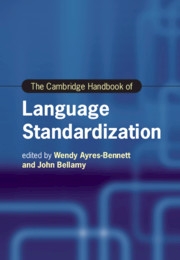Book contents
- The Cambridge Handbook of Language Standardization
- cambridge handbooks in language and linguistics
- The Cambridge Handbook of Language Standardization
- Copyright page
- Contents
- Figures
- Tables
- Contributors
- Introduction
- Part I Revisiting Models and Theories of Language Standardization
- Part II Legitimacy, Authority and the Written Form
- 7 Standard Languages in the Context of Language Policy and Planning and Language Rights
- 8 State-Appointed Institutions
- 9 Grammars, Dictionaries and Other Metalinguistic Texts in the Context of Language Standardization
- 10 An Industry Perspective
- 11 The Role of Literature in Language Standardization
- 12 Standardization, New Speakers and the Acceptance of (New) Standards
- 13 Creoles and Variation
- Part III Norms, Literacy and Education
- Part IV Beyond the National
- Part V Standardization in Late Modernity
- Name Index
- Subject Index
- References
13 - Creoles and Variation
from Part II - Legitimacy, Authority and the Written Form
Published online by Cambridge University Press: 01 July 2021
- The Cambridge Handbook of Language Standardization
- cambridge handbooks in language and linguistics
- The Cambridge Handbook of Language Standardization
- Copyright page
- Contents
- Figures
- Tables
- Contributors
- Introduction
- Part I Revisiting Models and Theories of Language Standardization
- Part II Legitimacy, Authority and the Written Form
- 7 Standard Languages in the Context of Language Policy and Planning and Language Rights
- 8 State-Appointed Institutions
- 9 Grammars, Dictionaries and Other Metalinguistic Texts in the Context of Language Standardization
- 10 An Industry Perspective
- 11 The Role of Literature in Language Standardization
- 12 Standardization, New Speakers and the Acceptance of (New) Standards
- 13 Creoles and Variation
- Part III Norms, Literacy and Education
- Part IV Beyond the National
- Part V Standardization in Late Modernity
- Name Index
- Subject Index
- References
Summary
Pidgins and creoles are typically depicted as involving an unusually high degree of variation. This is also often taken to be indicative of a lack of proper grammatical structuring and language-hood. Variation is presented as an obstacle to standardization and for exclusion from official domains, particularly formal education. For speakers, creoles represent the ‘voice of truth’, convey belonging and are often the main means of communication. Pidgins and creoles were eventually allowed into formal contexts due to pragmatic considerations such as for proselyting and for the mitigation of educational problems rather than identity-based considerations. This has acted as an important catalyst for their wider recognition. Discussions about how to deal with variation continue to hamper processes of standardization and implementation, however. This chapter reviews approaches to and issues in the standardization of creoles and discusses the ongoing standardization of Nenge(e) (Eastern Maroon Creoles) in French Guiana. It is argued that variation is integral to all languages and can be accommodated once pluricentric norms and wider notions of literacy are adopted. Careful attention to language ideologies, including views about variation, are crucial for successful acceptance and use of the outcomes of standardization.
- Type
- Chapter
- Information
- The Cambridge Handbook of Language Standardization , pp. 371 - 394Publisher: Cambridge University PressPrint publication year: 2021
References
- 2
- Cited by



